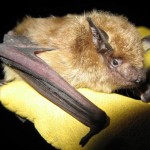
When winter arrives and insects are in short supply, most North American bats hibernate. But this long sleep also keeps the rabies virus alive in infected individuals, according to a new study.
Although only one or two people die from rabies each year in the United States, their infections are usually traceable to bats. In addition, bats are hosts for some “really nasty” diseases in other parts of the world, such as Bangladesh, Malaysia, and Australia, says lead author Dylan George, an infectious disease biologist at Colorado State University in Fort Collins. And yet very little is known about how viruses persist in bats without becoming deadly enough to wipe out their supply of hosts, George says.
To learn more, George and colleagues set up a mathematical model using data collected during a 5-year field study of big brown bats in Colorado. The model allowed the researchers to predict what happened if certain conditions, such as the virus’s incubation period (the elapsed time between infection and symptoms) or the length of hibernation, were to change.
As an infected bat hibernates, its metabolism slows enough to halt the progression of rabies—ensuring that the bat doesn’t die and take the virus out with it. In the spring, the females leave their hibernation roosts for colonies where they can go to give birth and raise their young—providing ideal conditions for the virus to spread: dozens of bats, many of them susceptible youngsters, crowded in warm environments, grooming themselves and nipping each other.
The team’s model held up when compared with data from the U.S. Centers for Disease Control and Prevention and the Colorado Department of Public Health and Environment, which show that the incidence of rabies peaks in the summer, with death rates highest among juvenile bats. The numbers imply that a long incubation is also essential, otherwise the bats would die before it’s time to hibernate.
“The study may explain why we never see huge rabies outbreaks in bats that lead to population crashes,” says wildlife biologist Paul Cryan of the U.S. Geological Survey in Fort Collins. “Using their mathematical model, the researchers showed that when you take hibernation out of the picture, both the bats and the virus go extinct.”
Infectious disease epidemiologist James Wood of the University of Cambridge in the United Kingdom says that the model by George and colleagues paves the way for studies of seasonal patterns in other bats harboring viruses that infect humans. For example, the bat-borne Nipah virus, which breaks out yearly in Bangladesh, kills up to 70% of the people it infects. And in Australia, the lethal Hendra virus passes from fruit bats to horses to humans. “Until we know the dynamics of infection in wildlife, we won’t understand the spillover from bats to humans,” Wood says.
Raina Plowright, infectious disease ecologist at Pennsylvania State University, University Park, is impressed by the way the researchers combined both field and laboratory data with a mathematical model. In a study published online May 11 in the Proceedings of the Royal Society B, her team used a model to show that outbreaks of the Hendra virus in Australia may be due to the bats’ coming into more contact with humans as urban areas spread into their habitat.
“Going into caves doesn’t give you a complete picture, and laboratory data don’t show what’s happening in the real world,” she says. “George and colleagues show powerfully that the only way to understand all the factors is with a mathematical model.”
Source: Science & AAAS

















